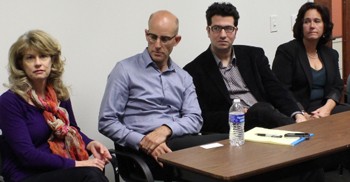It’s not news that digital media is a brave new world. Where regulatory protections are concerned, it’s the Wild West. The resulting tensions have been demonstrated in conflicts over AI in the entertainment industry, misinformation on social media, and applying section 230 of the Communications Decency Act to the internet. Internet-distributed digital media like podcasting, social media, and streaming are subject to less regulatory and legal oversight than legacy media, while at the same time tools to create and distribute digital media are now available to almost anyone. Lax regulatory oversight and a lack of uniform or professional production standards can be a risky combination, especially when telling “true crime” stories.
As the true crime genre has proliferated – much of it driven largely by entertainment and financial incentives – many creators have failed to balance public interest with the potential harm of re-telling the horrors inflicted on real people. Often, true crime creators consult neither journalistic ethics nor the real people harmed by the crimes they recount.
As true crime’s popularity has skyrocketed over the last decade, new media content creators have made millions of dollars on real victims’ stories. But is that profit being made ethically?
“I’m so tired of murder victims being used as cash cows.”
Charlie Shunick’s sister Mickey went missing in 2012. She was eventually found dead, and a man later pleaded guilty to her murder. He is serving a life sentence. On March 7, Charlie Shunick took to TikTok to address the “Crime Junkie” podcast’s coverage of her sister’s case, and the true crime industry at large.
“My sister was a very private person,” Shunick said. “What was the point of this? And if these [shows] have so much time to research what happened and look at all the information that exists, why don’t they have time to reach out to the family members?”
Shunick’s video addressed a growing sentiment about true crime content in new media.
In 2014, the investigative journalistic podcast “Serial,” a story of true crime and the criminal justice system, premiered at number 1 on Apple Podcasts. “Serial,” a program developed by Chicago Public Media’s “This American Life,” went on to win a Peabody Award, spur legal reexaminations of the underlying murder conviction, and attain dizzying financial success. The years post-Serial have seen a true crime boom in new media like podcasts, social media, and streaming. The year 2015 marked an uptick in true crime podcasts seeking to mimic Serial’s template, and by 2019 Chartable reported that five of the top 10 charting U.S. podcasts were true crime shows.
These shows focus on real stories of violent crimes, primarily murders (sometimes with accompanying sex crimes and attempted murders) or cult stories.
True crime creators usually recount stories from within the last 50 years, but not the most recent news. This focus is perhaps due to easy access to court records, which allows creators to rely on pre-existing research. Indeed, most content in this recent true crime boom has been not journalistic, but entertainment media. In a lot of true crime content, Charlie Shunick said, “people feel that just because a case is public information, it’s ethical to use it.”
The way these shows cover violent crime only calls creators’ intentions into greater question: “If they really care about victims,” Shunick continued, “… they would cover cases where people are begging for support. If [they’re] covering cases that are solved, that can be looked up easily, that millions of people are already familiar with, that are over a decade-plus old, there’s only one reason why they’re doing that.” That reason, Shunick contends, is profit.
True crime’s origins
Of course, prurient interest in the macabre or mysterious isn’t new. These themes surface in popular English-language fiction from Shakespeare’s “Macbeth,” to Shelley’s “Frankenstein,” to Conan Doyle’s Sherlock Holmes stories. Tragedies in news and history, particularly grim or shocking ones, also never fail to captivate society for generations. Stories of the Salem witch trials, the Titanic’s sinking, or storming the beaches of Normandy are forever resurfacing.
But much of the content created in the digital-media true crime boom differs significantly from journalism, fictional thrillers and horrors, or creative non-fiction crime stories (like Capote’s trailblazing ‘In Cold Blood’). With few exceptions — such as the journalist-fronted mainstay “Dateline” — the top-charting true crime podcasts of recent years are written and hosted by comedians, entertainers, and digital media marketers.
True Crime podcasting is a big business
By 2019, 28% of U.S. podcast listeners reported seeking out true crime as a favorite genre. In 2021, 20% of the top-searched shows on Apple podcasts, and curated recommendation lists, in the U.S. were true crime shows.
As many entertainers have discovered, the true crime genre is well-suited to a new media landscape that prioritizes “bingeability.” True crime presents content creators with an inexhaustible, cost-effective cache of stories, characters, and even sets.
Sarah Marshall is a writer, media critic, and host of “You’re Wrong About,” a podcast that examines and reconsiders historical events, people, and phenomena that have been miscast in the public imagination. While qualifying that true crime has always been popular, Marshall explained the recent boom: “You know what’s cheaper than making a movie? Generating media from actual crimes, actual trials…you’re never going to run out of material. Why bother creating fiction if there’s so much reality we can make into entertainment?”
Rachel Monroe, journalist and author of “Savage Appetites: Four True Stories of Women, Crime and Obsession,” shares Marshall’s belief that True Crime podcasting is a product and beneficiary of today’s unique media ecosystem.
“It’s this ‘bingeability,” Monroe said. “If you think about both podcasts and streaming series, you need something that will make people tune in for the next one – because we have so much culture, and it’s so easy to turn away to something else entertaining.”
In addition to the wealth of existing, serializable narratives available in the public record, true crime stories are easy to package into a compelling format.
“True crime has a combination of really high stakes and this question of mystery,” Monroe said. “It can be really sensational. You can find the X number of twists needed for the audience to stay interested, stay consuming. In that way, it’s really well-suited to the media imperatives of the moment.”
Following the money
And true crime sagas can make a lot of money for their creators. Podcast advertising alone has become an astronomical market (at least for top-charting shows) – advertisers spent approximately $700 million on podcasts in 2019. That same year, true crime staple “My Favorite Murder” made an estimated $15 million. The Last Podcast Network, formed around “Last Podcast on the Left,” is valued in the high tens-of-millions, and pulls in almost $90,000 per month in bonus Patreon subscriptions alone.
There’s relatively little overhead to whittle down these gross figures. A true crime show that strictly re-tells stories that have already been thoroughly covered saves time and money on research and writing. For any staff they do hire, labor protections come largely from the employer’s honor system. As in many branches of new media, regulatory protections, content oversight, and union establishments have yet to catch up with the podcasting industry.
Qui Bono?
Every new medium brings with it new challenges: regulation and social equity will take time to catch up with podcasting and streaming, just as they once had to with television and radio. But the risks presented by these new unregulated, high-profit media are heightened in true crime content.
Cheap, easy-to-use media tools are a double-edged sword: anyone can produce content without the hurdles historically posed to artistic or journalistic publication. But those institutional gatekeepers also ensured some measure of editing, quality control, and fact-checking.
“A lot of producers currently in the true crime arena have drifted over from reality TV,” said Paul Haynes, whose work in true crime has left him with deep concerns about the genre’s ethical profile. Haynes worked with the late Michelle McNamara on “I’ll Be Gone in the Dark,” the bestselling book investigating the “Golden State Killer.” He also co-produced the eponymous HBO docuseries.
Under existing law, crime survivors are not entitled to any rights of consultation or compensation for entertainment-based stories based on their personal traumas. And as a rule, the dead and the bereaved, are not a litigious demographic. True crime content creators may thus be less concerned about their perspectives.
Still, some survivors, like Charlie Shunick, have expressed misgivings about entertainment content made from their families’ stories. Rita Isbell’s brother Errol Lindsey was killed by Jeffrey Dahmer and depicted in a recent Netflix series. Isbell was not contacted about the show, despite her victim impact statement being quoted verbatim.
“I feel like Netflix should’ve asked if we mind or how we felt about making it,” Isbell told The Hollywood Reporter. “The victims have children and grandchildren. If the show benefited them in some way, it wouldn’t feel so harsh and careless. It’s sad that they’re just making money off of this tragedy. That’s just greed.”
Controversies have also arisen — some culminating in libel lawsuits — over false accusations originating in true crime media. In most such cases, true crime entertainers circulate pet theories that survivor(s) associated with a violent crime are actually culpable for it, leading to serious repercussions for the already bereaved.
Adaptable Legal Principles
The U.S. Constitution protects speech and press under the First Amendment. These rights are intended to protect people’s access to information, foster truth and progress, and allow dissent. However, speech can still be curtailed if it lacks enough creative, social, or informative value to outweigh the speech’s harm. The First Amendment does not protect harmful expressions that are “utterly without redeeming social value.” That’s why libel and dangerous speech like falsely yelling ‘fire!’ in a crowded theater, can be prohibited. Commercial speech or threats of violence thus receive less protection than education, art, or political critiques.
The U.S. Supreme Court and many states have recognized a “Right of Publicity” (also known as a right to name/image/likeness, or ‘life rights’). However, the current Right of Publicity is rooted in commercial intellectual property rights, not an individual right to privacy. While the right is “not just for celebrities, [but] inherent to everyone, to control the commercial use of identity and persona and recover in court damages,” it does little to protect non-public figures — those who never intended to profit off of their own story, but are now faced with others doing so.
In fact, a true crime survivor invoking their Right of Publicity could be forced to undermine their own argument — that gratuitous true crime content re-traumatizes victims — because the claim depends on survivors seeking their own commercial profit from their story. Legislators, already faced with adapting other regulatory protections in the face of new media, would have to expand definitions of those with ownership of their “life rights” beyond the commercial. Or, better codify the eroding right to privacy.
Power dynamics, demographics & systemic concerns
Statistically, violent crime in the United States disproportionately affects certain demographics. This means that true crime stories reflect the same victimology trends, and almost always recount violence against women, people of color, LGBTQ+ folks, sex workers, unhoused people, or a combination thereof.
These realities demand due diligence from creators, but too often, due diligence isn’t prioritized. In fact, some popular true crime hosts have been accused of abusing others. These reports have alleged patterns of hosts participating in, and covering up, years of physical or sexual abuse as well as accusations of perpetuating racism and bigotry.
Navigating this delicate sociocultural dynamic isn’t impossible, but it requires extra care and work. Paige St. John, a Pulitzer Prize-winning investigative journalist with the Los Angeles Times, did so with “Man In The Window,” her survivor-centric podcast on the Golden State Killer.
As an experienced professional, protective of journalist scruples and the personal sensitivities involved in victims’ stories, St. John centered survivors in her podcast. She worked directly with the Golden State Killer’s female victims, many of whom survived rape and assault, and male victims, who’d suffered either direct assault or the psychological trauma of watching their partners’ attacks. Survivors had struggled not just with the attack’s immediate trauma, but the ongoing pain of a society ill-equipped to support and acknowledge their needs.
St. John built trust with those she interviewed. She took time to tell their stories correctly and acted as an advocate for sensitivity when liaising with producers. Even still, she faced difficulties confronting industry expectations and culture that came with true crime’s commercial promise.
She says she also got lucky. St. John came to the project with a storied journalistic career, and her immediate producer supported her vision for “Man In The Window.” Nevertheless, some executives and higher-ups expressed that “the voices of older women would not work,” and asked her to “switch up” her first episode and subsequent scripts.
“They really lectured me and said you know, ‘there’s a reason that [their] format is so commercially popular – it works.’”
St. John’s team won out in the end, and “Man In The Window” proved incredibly popular.
“The reason ‘Man in the Window’ was so damn successful, I believe, [is that]… it spoke to, and with, these women, these people who are out there,” St. John said. “Our mothers, aunts, fathers, ourselves.”
“Man In The Window”’s success is proof that “those real stories can commercially work,” without such a simplified and formulaic approach. Of course, St. John’s approach is more difficult. It takes experience, expertise, time, and patience.
An exercise in quality, not quantity.









